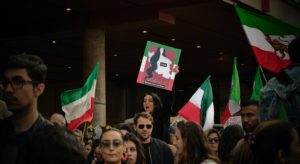Women, Life, Freedom
 Photo by Artin Bakhan on Unsplash
Photo by Artin Bakhan on Unsplash On September 13th, 2022, Iran’s Guidance Patrol, or “morality police,” arrested twenty-two-year-old Mahsa Amini for not wearing a hijab in accordance with dress code laws. Iranian authorities claim that, while in detention, Amini experienced a heart attack and was taken to a hospital, and on September 16th, Mahsa Amini died.
The circumstances surrounding Amini’s death quickly became the subject of furious dispute. According to the New York Times, photos and videos showed Amini in a hospital bed with bruises and blood coming from her ears, to which “several Iranian physicians said on Twitter that although they had no access to her medical file, bleeding from the ear suggested she had a concussion from injuries to the head.” Witnesses indicated Amini was beaten by authorities whilst inside the detention center, and members of her immediate family refuted statements she had died of natural causes, stating that, contrary to claims made by officials, she did not have the relevant medical history and had been in good health.
In a statement, UN experts expressed that Amini “is another victim of Iran’s sustained repression and systematic discrimination against women and the imposition of discriminatory dress codes that deprive women of bodily autonomy and the freedoms of opinion, expression and belief.” Thousands of protesters have flocked to the streets to demand justice for Amini and an “end to violence and discrimination against women in Iran, particularly compulsory veiling for women,” and women have also responded by removing and burning their veils and cutting their hair.
Protesters have been met with violent use of force by security forces, prompting the U.S. Department of State to impose sanctions on “Iran’s Morality Police and senior security officials who have engaged in serious human rights abuses,” stating, “the Iranian government needs to end its systemic persecution of women and allow peaceful protest.” Even in the face of violence and censorship, demonstrators have used social media to amplify outcry and spark international solidarity protests, notably with the use of the hashtags #MahsaAmini or #Mahsa_Amini, and the slogan ”Women, Life, Freedom.”
The situation unfolding in Iran is certainly a complex one, informed by a multitude of historical factors, yet stands as an example of the fascist principles that can arise under a theocratic regime. Yale Professor Jason Stanley asserts that there are ten tactics of fascism that can ”even occur in societies that do not have a fascist regime”—these include anti-intellectualism and the misconstruction of science or facts for autocratic gain, hierarchy and the oppression of minorities as a means of weaving moral narrative, law and order as a tool to subvert minority groups and enforce loyalty, and sexual anxiety as a means to accomplish fear and force.
Iran’s media censorship, curtailing of free speech and expression, utilization of violence by its security forces, sexist laws, and attempts to explain away the will of its people helps both explain why many Iranian protestors want regime change and prove what humanists are already aware of: a dominating religion in government will produce violence and regressive social outcomes, which is why there must be a wall between them.
Women and gender-expansive people benefit from a pluralist government. With inclusivity at the forefront, freedoms, such as the freedom of religion or belief, or freedom to comprehensive reproductive healthcare, remain expressed in the hands of individuals by their choices, instead of curtailed and subject to persecution by a governing body. In a piece by Australian SBS news, Dr. Derya Iner, an Islamic Studies researcher and lecturer, explains that women in France and India, who fight for the ability to wear the hijab, and women in Iran, who fight for the ability to not wear the hijab, are “facing the same struggle: ‘the authority is trying to control our bodies.’”
The exploitation of creeds, beliefs, or ideologies cannot be used to justify violence—women must have the autonomy to govern their own bodies, choices, and expressions.
